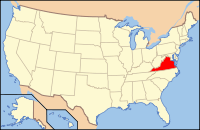Church Hill
|
St. John's Church Historic District | |
 | |
|
St.John's Episcopal Church, Richmond, Virginia | |
 | |
| Location | Bounded roughly by 22nd, Marshall, 32nd, Main, and Franklin Sts. and Williamsburg Ave., Richmond, Virginia |
|---|---|
| Coordinates | 37°31′45″N 77°25′5″W / 37.52917°N 77.41806°WCoordinates: 37°31′45″N 77°25′5″W / 37.52917°N 77.41806°W |
| Area | 100 acres (40 ha) |
| Architect | Byrd,William |
| Architectural style | Greek Revival, Federal |
| Governing body | Local |
| NRHP Reference # |
70000884 (original) |
| VLR # | 127-0192 |
| Significant dates | |
| Added to NRHP | September 15, 1970 |
| Boundary increase | January 17, 1991 |
| Designated VLR | June 2, 1970; April 17, 1990[2] |
Church Hill, also known as the St. John's Church Historic District, is an Old and Historic District in Richmond, Virginia. This district encompasses the original land plat of the city of Richmond. Church Hill is the eastern terminus of Broad Street, a major east-west thoroughfare in the Richmond Metropolitan Area, and one of the longest, which carries U.S. Route 250. The name Church Hill is often used to describe both the specific historic district and the larger general area in the East End encompassing other neighborhoods such as Union Hill, Chimborazo, Fairmount, Peter Paul, Woodville, etc.
History
Church Hill is known as the site of Virginia's second revolutionary convention where Patrick Henry gave his "Give me liberty or give me death" speech in St. John's Episcopal Church, Richmond, Virginia. It is also known for Chimborazo Park, where the largest American Civil War Hospital was located.
On Friday, October 2, 1925, a 4,000-foot Chesapeake and Ohio railroad single track tunnel built during Reconstruction collapsed under Church Hill. The Church Hill Tunnel collapse occurred during refurbishment works, killing 3 or 4 and engulfing a work train in complete with a 4-4-0 engine #231 and 10 flat cars. The tunnel was closed and filled-in after the collapse. In the July 2006, a coalition of officials and historical groups made plans to remove the buried engine. If recovered, it would be displayed at the Virginia Historical Society in Richmond. Some borings were made into the tunnel from above for examination by camera. Only murky water was found, whereupon further work was delayed by city permitting issues. The bricked-in entrance of the collapsed tunnel can still be seen at the south east end of the alley just north of Marshall Street, on 18th Street.
Douglas Wilder, the first African American to have been elected governor of a U.S. state1, was born and raised in Church Hill.
Crime
Church Hill was recently ranked as the 10th most dangerous neighborhood in the entire country.[3] This, however, is not accurate, as the area considered in this study is actually known as Church Hill North: a distinctly separate neighborhood containing the Mosby Court housing project north of Church Hill proper. The area in question is contained within the boundaries of the Church Hill Central Neighborhood and Church Hill North Old and Historic District.
Preservation Efforts
The Church Hill neighborhood experienced serious physical decline during the 1950s, owing mostly to absentee landlords. The Historic Richmond Foundation was established in 1956 by Elisabeth Scott Bocock out of concern for "saving and enhancing the setting for St. John's Church."[4] In 1957, encouraged in large part by Historic Richmond, City Council created a historic district ordinance while simultaneously adopting the St. John's Church Old and Historic District. The preservation of Church Hill marked the formal beginning of the preservation movement in Richmond.[5]
Notable Structures, Monuments and Parks
- St. John's Episcopal Church (Richmond, Virginia)
- Adams Double House
- Chimborazo Park
- Elmira Shelton House
- Jefferson Park
- Libby Hill Park
- Pohlig Brothers Building
- Richmond Hill former Adams-Taylor House
- Soldiers and Sailors Monument
- St. John's Mews
- Superior Warehouse
- Woodward House
- WRVA Building
Maps
References
- ↑ "National Register Information System". National Register of Historic Places. National Park Service. 2009-03-13.
- ↑ "Virginia Landmarks Register". Virginia Department of Historic Resources. Retrieved 19 March 2013.
- ↑ "25 Most Dangerous Neighborhoods in the Country Retrieved January 11, 2012". dailyfinance.com. July 11, 2011. Retrieved January 11, 2012.
- ↑ Zehmer, Jack. Church Hill: The St. John's Historic District, 1991. (p. 11)
- ↑ Katie Kelley, Historic Richmond Foundation Architectural Historian
External links
- Church Hill People's News
- Church Hill on myspace.com
- Church Hill neighbors on Yahoo!Groups
- Church Hill Association
- Historicrichmond.com info about Church Hill
- St. John's Episcopal Church
- Richmond City Watch: Church Hill
- Alliance to Conserve Old Richmond Neighborhoods (ACORN): Neighborhood Maps
- Richmond, Virginia, a National Park Service Discover Our Shared Heritage Travel Itinerary
| ||||||||||||||
| ||||||||||||||||||||||||||||||||||||||||||

